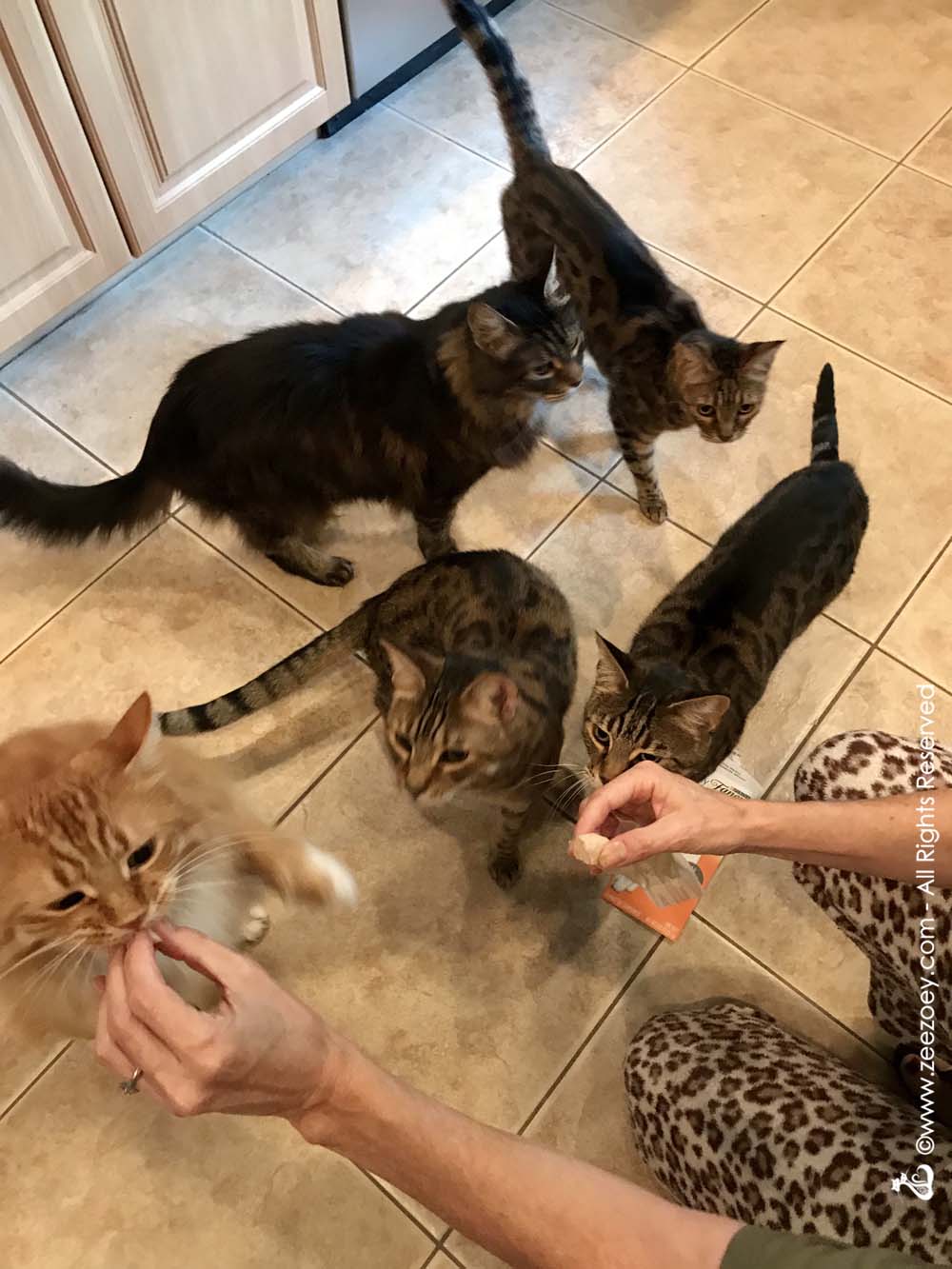Keepin’ the Peace in a Multi-Cat Household: Tips, Tricks and Practical Advice!
 It’s the story of any multi-cat household and it’s usually not intentional. It starts with that cute cat that was given to you as a gift, because, well, it needs a home and who else better than you to give it one? And then that rescue you had to help with, resulting in you taking the cat home because goodness knows what would have happened to him had you not stepped in. And of course, that foster stint that was supposed to be temporary but was a resounding failure, represented by the cat contentedly taking residence on your bed, along with that cat that showed up out of nowhere on your doorstep that you were going to feed “just that one time,” that you have now been feeding for over two years…and just like that, you’re officially a multi-cat household.
It’s the story of any multi-cat household and it’s usually not intentional. It starts with that cute cat that was given to you as a gift, because, well, it needs a home and who else better than you to give it one? And then that rescue you had to help with, resulting in you taking the cat home because goodness knows what would have happened to him had you not stepped in. And of course, that foster stint that was supposed to be temporary but was a resounding failure, represented by the cat contentedly taking residence on your bed, along with that cat that showed up out of nowhere on your doorstep that you were going to feed “just that one time,” that you have now been feeding for over two years…and just like that, you’re officially a multi-cat household.
Your intentions were good, but cats by nature are averse to change and territorial. For your currently residing cats, each new introduction can swiftly disrupt the existing hierarchy and delicate equilibrium, resulting in full-blown war, complete with fur flying, hissing, and blood-curdling meows of protest. All of this leaving you wondering if your household will ever function in peace and harmony again. The good news is, yes, with some tips, tricks, perseverance and practical advice, you can keep the peace in a multi-cat home, or at the very least, keep the mayhem down to a manageable minimum.
![]()
Cats have unique and diverse personalities, baggage and history, so to build a solid, long-lasting foundation of trust (or at least, tolerance), between existing cats and a new cat, resist the temptation to let everyone meet each other right away. Slow and steady wins the race. Put the newcomer in a safe area that you can keep shut off from the other cats, such as a spare bedroom. Provide a litter box, food and water dishes, toys, a scratching post, bedding, and a safe hiding area such as a cat tower.

Keeping the door to the safe room the new cat is staying in is important to easing introductions with the other household cats.
Cats have a heightened sense of smell so a new cat in the mix is high on the list of scents that could trigger an adversarial reaction. Try scent swapping to ease introductions – use a clean towel and gently pat the new cat’s cheek to transfer her pheromones onto the towel. Repeat the same procedure on each resident cat and place the towels where the other cat hangs out (but not near the food or litter boxes) and continue this exchange several times a day so each cat can become familiar with the different scents.
Be patient and gradually introduce the cats to one another. Open the door a crack to let them sniff each other – do not have all the cats meet the new addition at the same time and stay close by to supervise. Gradually incorporate positive reinforcements to the mix by feeding your cats treats or meals simultaneously, separated by the closed door. If they won’t eat or display aggression towards each other, back the food away from the closed door to a more comfortable eating distance and over the course of time, slowly move the feeding stations closer to the door until they are eating next to each other (still separated by the closed door) without displaying aggression. Give the new cat some time to explore their new home in peacetime, too. Put your resident cats in a spare room and let your new cat out to sniff a larger area of the house without fear of the other cats attacking her and keep the door open to her “safe place” in case she feels the need to run in for security. Transition to putting one or two resident cats in the newcomer’s room to sniff her surroundings while she is exploring the rest of the house.

When it’s clear trouble is brewing, time to distract the cats with something such as a loud noise to avoid a fight.
Cats are not fans of change so try to keep feeding, playtime, and everyday routines on schedule. Even the slightest change of routine with a cat can cause a negative reaction, so if there’s hissing, fighting, or displaced aggression, it’s not because they’re being bad. It’s instinct and they should NOT be punished for acting out, but rather the behaviors should be re-diverted to positive channels such as through playtime or treat association. Negative energy can also be dispelled with loud noises or barriers – consider putting some pennies into a metal container and shake it when the altercation occurs to startle the cats or have a piece of stiff cardboard available to quickly put between the fighting cats.

Because cats are territorial and have the need for protection and privacy (stemming from either needing privacy to hunt prey or protection from lurking dangers), according to Jackson Galaxy, cat behaviorist, author, and star of Animal Planet’s My Cat From Hell, “access to vertical space is not a luxury, it’s a necessity.” When a newcomer is added to the mix it makes it all the more important because in order for cats to get along, they need access to personal space and the best way to do that is to redefine how much territory there is. There are numerous items on the market – from shelves, you can install on your walls to cat trees and condos. Even well-placed items already in your home can work – bookshelves, dresser tops, mantles and more – all are all ways to create territorial space. Ideally, these items should be connected like a superhighway allowing the cats to walk, run, or jump from place to place without touching the floor. For ideas on how to redefine the territory in your home, consider reading Catify to Satisfy: Simple Solutions for Creating a Cat-Friendly Home by Jackson Galaxy and Kate Benjamin of Hauspanther.

This multi-tiered cat tree from Pet Tree Houses serves many positive purposes – high spots for territorial space, scratching posts, and lots of shelves so more than one cat can share the tree.

Not only is it better for your cat’s health to be spayed or neutered, but it also greatly reduces territorial and negative behavioral issues that can occur in a multi-cat home of varying personalities and aggression levels. Marilyn Krieger, Certified Cat Behavior Consultant states, “unfixed cats typically define their territories through urine marking, such as spraying, and they fight to defend their territories, making it harder to integrate them.” The sooner the better, too. Even if you’ve brought a kitten into the mix, a kitten can be spayed as early as 8 and 12 weeks (or as soon as they weigh at least 2 pounds). Spaying your female prior to her first heat also reduces her risk of uterine infections, uterine cancer, and mammary cancer and neutering your male before he is 6 months of age prevents testicular and prostate cancer.

However many litter boxes you have, keep them spotlessly clean. You wouldn’t want to do your business in a dirty bathroom and neither does your cat. Cats are also compulsively territorial when it comes to litter habits, so regular scooping is a must. So is a thorough cleaning of the boxes on a regular basis; and paying attention to the signs your cat is giving you. If you notice accidents outside of the box, or spraying, or other marking habits throughout the house, you might need to add more litter boxes to the equation. The location of the litter box is important, too – make sure the cat has an easy escape route so he doesn’t feel threatened or trapped by another cat that might be ganging upon him. The size of the box, the type of litter used, a box with a lid, or without a lid, and so much more can play into a cat’s behavior when sharing a litter box with other cats. Of course, negative litter habits may also be a sign something is amiss – a trip to the veterinarian might be necessary in case the cat has an infection or some other ailment that may be the root cause of the problem.

Just like humans, cats with little or no exercise or environmental stimulation can become bored, obese and vulnerable to diseases which include arthritis, heart disease, diabetes, and liver problems. Living the same daily routine can also cause physiological stress to a cat, manifesting itself in many ways, such as the cat destroying furniture, not using the litter box, or acting aggressively with the other cats in the household.

An assortment of toys, cat condos, and scratching options all help to enrich a cat’s mind, body, and spirit.
Because cats instinctively nap up to 16 hours a day, a mechanism to reserve energy to keep their hunting skills sharp, this makes it crucial to provide them with proper enrichment to expel that pent-up energy, as most cats live indoors and no longer have the need to hunt for survival. Provide them with numerous scratching post options to allow them to stretch and exercise their claws and lots of vertically shaped pieces of furniture to jump up to so they feel a territorial sense of ownership. An assortment of appropriate toys so they can mimic their need to stalk, hunt, and “kill” prey – all of this is critical to keeping your cats optimally happy and healthy, which in turn will help keep the peace and enhance the feline-feline bond.

The rewards of a richly enhanced environment toward long-lasting peace and feline-feline bonding are self-evident when all is well.

For most cats, treats and playtime activities, such as chasing a feather dangling from a wand, are irresistible. Establishing routines that allow for these activities to be done collectively signals to them something positive and enjoyable will occur. Each cat will have different degrees of participation, but as long as the environment feels safe and rewarding, that’s the key to a successful interaction.

Whether two cats, three or more, each of them needs individual attention every day from you. You are their caretaker – the master of food, treats, clean litter, and more and as such, you are very beloved to them. Feelings of jealousy can easily crop up and each cat needs to feel important in the hierarchy and that the new cat is not a threat to their position in the household. Whether it’s sharing some lap time, or bonding by some hands-on grooming and brushing, or some shared playing with a favorite toy, give each cat a daily dose of you.

Spending quality, one-on-one time with each cat is important to them feeling loved and respected within both the feline-feline hierarchy and feline-human relationship.
You should also be mindful and respectful of your current household dynamic. You can’t control every situation or know every answer, but if you do decide to bring a new cat into the mix, ask yourself if you think the cat has the personality or capabilities to handle themselves with your existing cats without too much undue stress or trauma. While there is no guarantee to this method, evaluating your living arrangements, the personalities of your other cats, and how much time and effort you can put into easing a new cat into your household is extremely important to any decision you make to adopt a new cat.
Multi-cat households are not for everyone, but for those who do have more than one cat, it can be one of the most rewarding and fulfilling aspects of your life. Not only will you experience the joys of the feline-human bond, but for those cats that click together, it truly is beautiful to witness the bond they can share with one another. And there are so many cats that could use a good home – from sweet, happy, and healthy young kittens to senior cats, to cats with disabilities or illnesses. All of them want to be loved, but they need to be placed in an environment that is best suited to their needs and the needs of your other cats to make it work out. If you are considering adding to your already multi-cat home just remember a pet is a lifetime commitment and you want everyone to be as happy and stress-free as possible.

Me on any given night of the week – not only is multi-cat peace possible, it’s highly probable with the right environment.
For further information on subjects important to keeping your cats happy and healthy in a multi-cat home, please consider some of the other articles I’ve written:
New Kitten on the Block, Kittens 101, 2016 Edition
10 Tips to Relieve Feline Boredom in the Same Old 24/7 Environment
Spay it Forward for World Spay Day and Share the Facts on Cats, Kittens, Conception, and Spay/Neuter


























Great information, Deb. Having a multi-cat household means you always have at least one cat on your lap!
Ah, if only I had this advice earlier! Since our first failure at introductions, we researched and learned, but anyone considering a muli-cat household should save this post as a reference!
Such sage advice. We have never been in the position of allowing another feline to live here, so we have been spared the worry, stress and strains. This, however, I will bookmark for future use.
Purrs
ERin
Such excellent advice!
Excellent suggestions and great referrals to Jackson and Kate, who are feline experts! These tried-and-true methods are a “must” for harmony in the home, spay/neuter being #1.
Vertical cat furniture and feather wand toys are favorites here.
My Baby Su jumped up on the bed a week ago to get into her favorite spot, not realizing Elvis had usurped it. For the first time that I know of, they got into it and I had to squirt them to break up the rolling ball of feline rage. Since then, there has been no aggression and they seem to be respectful of each other’s habits and spaces. It’s not love — it’s more like detente — but we’ll take it!
Excellent post. I know all about living with a lot of cats, I have a dozen and at one point, when I started blogging, I had 15 🙂
Such great advice for anyone thinking of having a multi-cat house. We’ve never had more than three at once here, but this advice would still have been helpful!
Some Great advice there!Rabbits are even worse when it comes to introducing a new one….they like change even less than a cat,xx Speedy
Great post ! Excellent advice ! Purrs
Oh, we tried EVERYTHING to get Angel and Da Boyz to at least ignore each other, but Da Boyz just kept hoping up to where Angel was, and she would get mad. Lucky for us, we have enough room to give each their own apartment, and never the twain shall meet!